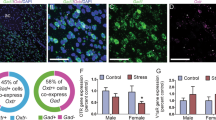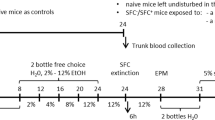Abstract
Rationale
To better understand anxiety disorders with social impairments as well as to identify new treatments, it is important to develop preclinical procedures involving social components of anxiety. Recently, a novel procedure was reported: the rat Social Approach–Avoidance (SAA) test. In this test, the time spent by a test rat in a large social compartment containing an unfamiliar stimulus rat reflects the anxiety state of the animal. It was shown that prestressing the test rat increased the avoidance of the social compartment as characterized by an increase in the time spent in the nonsocial compartment.
Objective
(1) To use a high-anxiety strain, F-344 rats, instead of prestressed animals, (2) to automate the test by using video tracking to measure time spent in both compartments and their subdivisions, and (3) to validate this modified test with known benzodiazepine receptor ligands.
Materials and methods
F-344 rats were treated with either chlordiazepoxide or diazepam (benzodiazepine receptor agonists), or RO 19-4603 or FG 7142 (benzodiazepine receptor inverse agonists).
Results
The agonists produced anxiolytic-like effects, whereas the inverse agonists produced anxiogenic-like effects. These effects were most marked in the two extreme zones in terms of distance to the stimulus rat.
Conclusions
F-344 rats display spontaneous avoidance behavior in the modified SAA procedure, and approach–avoidance behavior in these rats is sensitive to benzodiazepine agonists and inverse agonists in a bidirectional manner. The finding that the assessment of time spent into two virtual zones in each of the compartments markedly increased the sensitivity to both anxiolytics and anxiogenics will be discussed using the concept of physical defensive distance.





Similar content being viewed by others
References
Bandelow B, Zohar J, Hollander E, Kasper S, Moller HJ (2002) World Federation of Societies of Biological Psychiatry (WFSBP) guidelines for the pharmacological treatment of anxiety, obsessive–compulsive and posttraumatic stress disorders. World J Biol Psychiatry 3:171–199
Belzung C, Misslin R, Vogel E (1990) Anxiogenic effects of a benzodiazepine receptor partial inverse agonist, RO 19-4603, in a light/dark choice situation. Pharmacol Biochem Behav 36:593–596
Bert B, Fink H, Huston JP, Voits M (2002) Fischer 344 and Wistar rats differ in anxiety and habituation but not in water maze performance. Neurobiol Learn Mem 78:11–22
Berton O, Ramos A, Chaouloff F, Mormde P (1997) Behavioral reactivity to social and nonsocial stimulations: a multivariate analysis of six inbred rat strains. Behav Genet 27:155–166
Brodkin ES, Hagemann A, Nemetski SM, Silver LM (2004) Social approach–avoidance behavior of inbred mouse strains towards DBA/2 mice. Brain Res 1002:151–157
Crawley JN, Belknap JK, Collins A, Crabbe JC, Frankel W, Henderson N, Hitzemann RJ, Maxson SC, Miner LL, Silva AJ, Wehner JM, Wynshaw-Boris A, Paylor R (1997) Behavioral phenotypes of inbred mouse strains: implications and recommendations for molecular studies. Psychopharmacology (Berl) 132:107–124
File SE, Hyde JR (1978) Can social interaction be used to measure anxiety? Br J Pharmacol 62:19–24
File SE, Pellow S, Braestrup C (1985) Effects of the beta-carboline, FG 7142, in the social interaction test of anxiety and the holeboard: correlations between behaviour and plasma concentrations. Pharmacol Biochem Behav 22:941–944
File SE, Seth P (2003) A review of 25 years of the social interaction test. Eur J Pharmacol 463:35–53
Gray JA, McNaughton N (2000) Ethology and anxiety. In: Gray JA, McNaughton N (eds) The Neuropsychology of anxiety, 2nd edn. Oxford Psychology Series, Oxford University Press, Oxford
Griebel G, Belzung C, Perrault G, Sanger DJ (2000) Differences in anxiety-related behaviours and in sensitivity to diazepam in inbred and outbred strains of mice. Psychopharmacology (Berl) 148:164–170
Haller J, Bakos N (2002) Stress-induced social avoidance: a new model of stress-induced anxiety? Physiol Behav 77:327–332
Haller J, Leveleki C, Baranyi J, Mikics E, Bakos N (2003) Stress, social avoidance and anxiolytics: a potential model of stress-induced anxiety. Behav Pharmacol 14:439–446
Herbert JD, Hope DA, Bellack AS (1992) Validity of the distinction between generalized social phobia and avoidant personality disorder. J Abnorm Psychol 101:332–339
Kessler RC, McGonagle KA, Zhao S, Nelson CB, Hughes M, Eshleman S, Wittchen HU, Kendler KS (1994) Lifetime and 12-month prevalence of DSM-III-R psychiatric disorders in the United States. Results from the National Comorbidity Survey. Arch Gen Psychiatry 51:8–19
Lightowler S, Kennett GA, Williamson IJ, Blackburn TP, Tulloch IF (1994) Anxiolytic-like effect of paroxetine in a rat social interaction test. Pharmacol Biochem Behav 49:281–285
Magee WJ, Eaton WW, Wittchen HU, McGonagle KA, Kessler RC (1996) Agoraphobia, simple phobia, and social phobia in the National Comorbidity Survey. Arch Gen Psychiatry 53:159–168
McNaughton N, Corr PJ (2004) A two-dimensional neuropsychology of defense: fear/anxiety and defensive distance. Neurosci Biobehav Rev 28:285–305
Mormede P, Ramos A (2000) Genetics and emotional behaviors: experimental studies. In: Jones CJ, Mormede P (eds) Neurobehavioral genetics, methods and applications. CRC, Boca Raton, pp 301–315
Ramos A, Berton O, Mormede P, Chaouloff F (1997) A multiple-test study of anxiety-related behaviours in six inbred rat strains. Behav Brain Res 85:57–69
Ramos A, Mormede P (1998) Stress and emotionality: a multidimensional and genetic approach. Neurosci Biobehav Rev 22:33–57
Reich J, Goldenberg I, Vasile R, Goisman R, Keller M (1994) A prospective follow-along study of the course of social phobia. Psychiatry Res 54:249–258
Rex A, Voigt JP, Fink H (1999) Behavioral and neurochemical differences between Fischer 344 and Harlan–Wistar rats raised identically. Behav Genet 29:187–192
Rex A, Voigt JP, Gustedt C, Beckett S, Fink H (2004) Anxiolytic-like profile in Wistar, but not Sprague–Dawley rats in the social interaction test. Psychopharmacology (Berl) 177:23–34
Sams-Dodd F (1995) Automation of the social interaction test by a video-tracking system: behavioural effects of repeated phencyclidine treatment. J Neurosci Methods 59:157–167
Sareen L, Stein M (2000) A review of the epidemiology and approaches to the treatment of social anxiety disorder. Drugs 59:497–509
Shulman ID, Cox BJ, Swinson RP, Kuch K, Reichman JT (1994) Precipitating events, locations and reactions associated with initial unexpected panic attacks. Behav Res Ther 32:17–20
Toit PL, Stein DJ (2003) Social anxiety disorder. In: Nutt DJ, Ballenger JC (eds) Anxiety disorders. Blackwell, Oxford, pp 95–124
Turner SM, Beidel DC, Townsley RM (1992) Social phobia: a comparison of specific and generalized subtypes and avoidant personality disorder. J Abnorm Psychol 101:326–331
Acknowledgement
We thank Françoise Kahn for her excellent technical assistance.
Author information
Authors and Affiliations
Corresponding author
Rights and permissions
About this article
Cite this article
Nicolas, L.B., Prinssen, E.P.M. Social approach–avoidance behavior of a high-anxiety strain of rats: effects of benzodiazepine receptor ligands. Psychopharmacology 184, 65–74 (2006). https://doi.org/10.1007/s00213-005-0233-y
Received:
Accepted:
Published:
Issue Date:
DOI: https://doi.org/10.1007/s00213-005-0233-y




